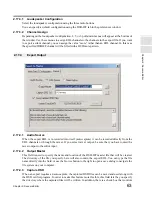
Chapter 3: Sonoma Mixer
73
Chapter 3:
Sonoma Mixer
The Sonoma Mixer has eight full and eight short channels for input, a center section, and various
meters including a set of meters to check compliance with the signal requirements laid down in
Annex D of the
Scarlet Book V1.2, Part 2 (Audio Specification)
,
6
and the recommendations laid
down in Annex E of the same document. The final DSD stream, i.e., the one that will be put onto an
SACD, must meet the signal requirements laid down in Annex D. It is preferable that the signal also
meet Annex E requirements, though this is not mandatory. If the signal requirements laid down in
Annex D are not met, a disc replicator will not press the disc.
The mixer supports simultaneous stereo and six-channel surround mixes, with additional loudspeaker
controls. There are insert points for channels and program, an AUX bus, and equalization and
filtering for both channels and program. An internal triangular wave oscillator with variable
frequency and level is available on each channel input. Please refer to
Figure 3-5
and
Figure 3-6
for
block diagrams of the Sonoma Mixer.
Dedicated windows provide user controls for managing the mixer’s processing resources:
•
The Control window appears when the Sonoma application is launched. From this window you
can configure and manage the other windows that comprise the Sonoma Mixer.
•
The Setup window sets the loudspeaker gain trim levels, displays clock information, and allows
the user to select the mixer’s clock source.
•
The Patch Bay allows fully flexible routing including one-to-many “fan-out” connections.
•
The EQ Center Section contains meters and global controls.
•
The EQ and Dynamics Section, also called the Channel Section, contains eight input channel
strips.
When the Sonoma application is launched, the state of the mixer is initialized to the state it was in the
last time the application was running. The mixer state can be saved and restored from files on the
system disk via the snapshot controls in the EQ center section.
The on-screen mixer controls are activated by using the left mouse button. There are three types of
controls: push buttons, dials, and faders.
Push button controls can be switched into two positions,
in
or
out
. The out position is indicated by a
grey background and the in position is highlighted in color: the color depending on the type of button.
When a button is out, it is switched in via a mouse button in. Conversely, when a button is in, it is
switched out via a mouse button up. This mimics the down and up behavior of many physical
switches.
3.1
Overview
6.
Super Audio CD System Description Part 2: Audio Specification
published by Royal Philips Electronics and Sony
Corporation.
3.2
Screen Controls
3.2.1
Push buttons
















































